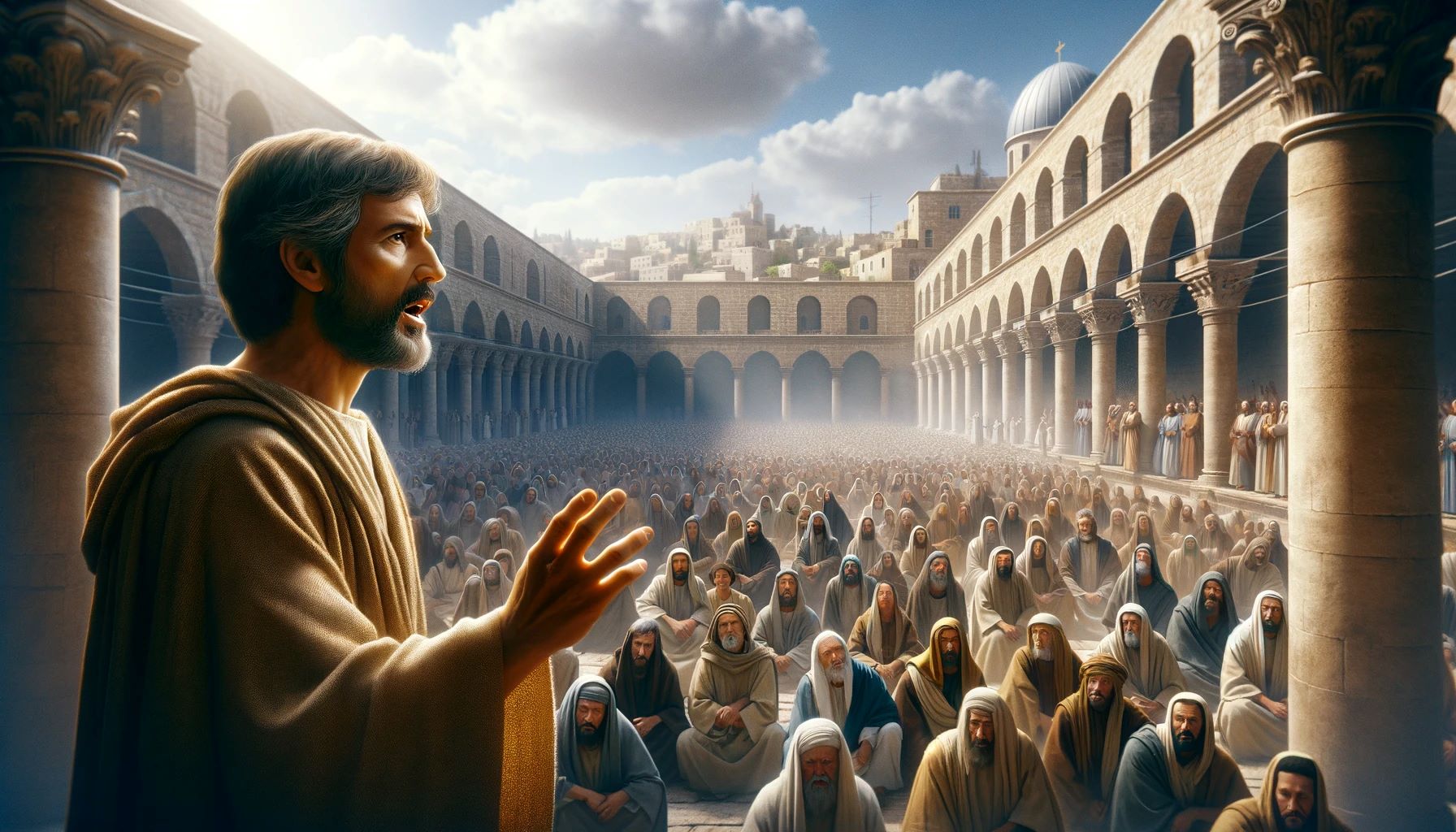Home>Bible Facts>What Happened To The Church After The Apostles Died


Bible Facts
What Happened To The Church After The Apostles Died
Published: February 22, 2024
Peter Smith, Editorial Director at Christian.net, combines deep insights into faith, politics, and culture to lead content creation that resonates widely. Awarded for his contributions to religious discourse, he previously headed a major organization for religious communicators, enhancing dialogue on faith's societal impacts.
Discover the fascinating history of the early Christian church and its development after the apostolic era. Explore intriguing Bible facts and insights.
(Many of the links in this article redirect to a specific reviewed product. Your purchase of these products through affiliate links helps to generate commission for Christian.net, at no extra cost. Learn more)
Table of Contents
Introduction
The period following the deaths of the apostles marked a significant transition in the history of the Christian church. This era was characterized by a series of transformative events that shaped the trajectory of Christianity and its impact on the world. As the early followers of Jesus, who had directly experienced His teachings and miracles, passed away, the responsibility of preserving and spreading the message of Christianity fell to subsequent generations. This pivotal juncture witnessed the evolution of church structure, the emergence of influential leaders, the formulation of Christian doctrine, and the enduring resilience of the faith in the face of persecution.
The post-apostolic era was a time of both challenge and opportunity for the burgeoning Christian community. With the apostles no longer present to provide direct guidance, believers were tasked with navigating the complexities of a rapidly changing world while upholding the teachings of Jesus. This period also saw the expansion of Christianity beyond its Jewish roots, as it gained traction among diverse cultural and ethnic groups across the Roman Empire and beyond.
The subsequent sections of this article will delve into the multifaceted developments that unfolded after the apostolic age, shedding light on the spread of Christianity, the evolution of church structure, the influential role of church leaders, the formulation of Christian doctrine, the harrowing experiences of persecution and martyrdom, and the emergence of various Christian sects. By exploring these key aspects, we can gain a deeper understanding of the profound impact of the post-apostolic era on the trajectory of Christianity and its enduring legacy.
The Spread of Christianity
The post-apostolic era witnessed a remarkable expansion of Christianity beyond its origins in the Jewish community. This period marked a pivotal shift as the message of Jesus began to resonate with diverse cultural and ethnic groups across the Roman Empire and beyond. The spread of Christianity was propelled by a combination of factors, including the fervent dedication of early believers, the strategic dissemination of the gospel, and the profound relevance of Christian teachings in the context of the ancient world.
One of the key catalysts for the spread of Christianity was the unwavering commitment of early followers to share the message of Jesus. Despite facing formidable challenges and persecution, these devoted individuals embarked on journeys to distant lands, carrying with them the transformative message of salvation and hope. Their unwavering zeal and conviction played a pivotal role in laying the foundation for the global expansion of Christianity.
Furthermore, the strategic dissemination of the gospel contributed significantly to the widespread adoption of Christianity. Early Christian missionaries and evangelists employed various means to propagate the teachings of Jesus, including oral communication, written correspondence, and the establishment of vibrant Christian communities. These efforts facilitated the organic growth of the faith, as individuals from diverse backgrounds were drawn to the profound message of love, redemption, and spiritual renewal.
Moreover, the intrinsic relevance of Christian teachings in the context of the ancient world played a crucial role in the rapid spread of the faith. The message of Jesus offered a compelling alternative to the prevailing religious and philosophical systems of the time, resonating with individuals who sought meaning, purpose, and a deeper connection with the divine. The emphasis on compassion, forgiveness, and the inherent worth of every individual struck a chord with people from various cultural and social strata, leading to a groundswell of interest in the Christian message.
As a result of these interconnected factors, Christianity experienced a remarkable expansion during the post-apostolic era, transcending geographical and cultural boundaries to become a global phenomenon. The enduring impact of this widespread dissemination continues to shape the fabric of contemporary society, underscoring the enduring relevance of the message that began to spread following the apostolic age.
The Development of Church Structure
The post-apostolic era witnessed a significant evolution in the organizational structure of the Christian church. As the early Christian community expanded and matured, the need for cohesive governance and administrative framework became increasingly apparent. This period marked the gradual transition from informal gatherings of believers to the establishment of structured ecclesiastical systems that would shape the trajectory of Christianity for centuries to come.
One of the pivotal developments in the evolution of church structure was the emergence of hierarchical leadership roles within the Christian community. As the influence of Christianity grew, the need for ordained leaders to provide spiritual guidance and oversee the affairs of the church became evident. This led to the establishment of distinct offices, such as bishops, presbyters (elders), and deacons, each entrusted with specific responsibilities aimed at fostering spiritual growth, nurturing the faith community, and facilitating the practical aspects of church life.
Furthermore, the development of church structure was closely intertwined with the establishment of formal places of worship and communal gatherings. The early Christian communities, initially meeting in private homes and secluded spaces, gradually transitioned to dedicated church buildings that served as focal points for congregational worship, instruction, and communal activities. These physical structures not only provided a sense of permanence and stability but also symbolized the growing influence and visibility of Christianity within the broader societal landscape.
Additionally, the post-apostolic era witnessed the formulation of organizational frameworks to address doctrinal and administrative matters within the church. Councils and synods were convened to deliberate on theological issues, resolve doctrinal disputes, and establish guidelines for ecclesiastical governance. These deliberative bodies played a crucial role in shaping the doctrinal identity of the Christian faith and fostering unity among diverse Christian communities.
The development of church structure during the post-apostolic era laid the groundwork for the enduring organizational framework of the Christian church. The hierarchical leadership model, the establishment of formal places of worship, and the formulation of organizational frameworks set the stage for the institutionalization of Christianity and its enduring impact on the course of history.
The evolution of church structure during this era reflects the dynamic interplay between spiritual ideals and practical considerations, underscoring the adaptive nature of the Christian faith as it navigated the complexities of a changing world. This transformative phase laid the foundation for the enduring legacy of the Christian church, shaping its identity and influence in the centuries to come.
The Role of Church Leaders
The post-apostolic era marked a pivotal phase in the emergence of influential church leaders who played a central role in guiding and shepherding the burgeoning Christian community. As the early Christian movement expanded and diversified, the need for capable and visionary leaders became increasingly pronounced. These leaders, entrusted with the spiritual oversight and pastoral care of the faithful, wielded significant influence in shaping the trajectory of Christianity and nurturing the fledgling communities of believers.
One of the central figures in the post-apostolic church leadership was the bishop, who assumed a pivotal role in providing spiritual guidance, overseeing the administration of local congregations, and upholding doctrinal integrity. The bishops, often regarded as successors to the apostles, served as unifying figures within their respective regions, fostering unity and cohesion among the diverse Christian communities. Their leadership was instrumental in preserving the doctrinal purity of the faith and addressing theological challenges that arose in the wake of the apostolic age.
In addition to bishops, presbyters (elders) played a crucial role in the pastoral care and governance of the early Christian congregations. These respected leaders provided spiritual counsel, nurtured the faith of believers, and facilitated the practical aspects of church life. Their wisdom and experience were invaluable in fostering a sense of community and mutual support among the members of the church, contributing to the spiritual vitality and resilience of the Christian communities.
Furthermore, deacons emerged as essential figures in the post-apostolic church leadership, undertaking practical responsibilities aimed at serving the needs of the community and extending compassionate assistance to those in need. Their selfless dedication to acts of charity, social welfare, and practical service exemplified the compassionate ethos of Christianity and underscored the integral role of benevolent outreach within the early Christian ethos.
The role of church leaders during the post-apostolic era was characterized by a deep sense of commitment to the spiritual well-being of the faithful, the preservation of doctrinal integrity, and the practical care of the community. Their collective efforts contributed to the establishment of a robust ecclesiastical framework that provided stability, guidance, and pastoral support to the burgeoning Christian movement. The enduring legacy of these early church leaders continues to resonate within the contemporary Christian tradition, underscoring the profound impact of their visionary leadership and unwavering dedication to the flourishing of the faith community.
The Formation of Christian Doctrine
The post-apostolic era witnessed a profound and intricate process of formulating Christian doctrine, a pivotal undertaking that shaped the theological identity and doctrinal framework of the burgeoning Christian faith. As the early Christian community grappled with theological questions and doctrinal challenges, the need to articulate and codify essential beliefs and teachings became increasingly apparent. This period of doctrinal development was marked by rigorous theological reflection, spirited debates, and concerted efforts to articulate the foundational tenets of the Christian faith.
One of the central themes in the formation of Christian doctrine was the articulation of core beliefs regarding the nature of God, the person of Jesus Christ, the Holy Spirit, and the redemptive significance of Christ's life, death, and resurrection. The early Christian theologians and church leaders engaged in profound theological reflection, drawing upon the teachings of the apostles and the sacred scriptures to elucidate the fundamental truths that undergirded the Christian faith. These deliberations led to the articulation of key doctrinal formulations, such as the nature of the Trinity, the divinity of Christ, the atonement, and the nature of salvation, which became foundational pillars of Christian orthodoxy.
Furthermore, the process of formulating Christian doctrine involved addressing theological controversies and doctrinal disputes that arose within the early Christian community. Councils and synods were convened to deliberate on contentious theological issues, resolve doctrinal disagreements, and establish authoritative statements of faith. These deliberative gatherings, such as the Council of Nicaea and the Council of Chalcedon, played a pivotal role in clarifying and affirming essential doctrinal truths, thereby safeguarding the doctrinal integrity of the Christian faith.
Moreover, the formulation of Christian doctrine was closely intertwined with the interpretation and exposition of the sacred scriptures. Early Christian theologians and exegetes undertook the task of elucidating the biblical texts, discerning their theological implications, and articulating coherent theological frameworks that harmonized the diverse strands of biblical revelation. This exegetical endeavor contributed to the development of doctrinal formulations that reflected the scriptural foundations of the Christian faith, providing a robust theological framework for subsequent generations of believers.
The process of formulating Christian doctrine during the post-apostolic era laid the groundwork for the enduring theological identity of the Christian faith. The doctrinal formulations that emerged from this period continue to shape the theological landscape of Christianity, serving as enduring touchstones of orthodoxy and theological reflection. The profound theological insights and doctrinal formulations that crystallized during this era continue to inform and inspire the theological discourse within the Christian tradition, underscoring the enduring significance of the formative period in the development of Christian doctrine.
Read more: What Happens After Confession
Persecution and Martyrdom
The post-apostolic era was marked by intense persecution directed against the early Christian community. As Christianity began to gain prominence and visibility, it encountered resistance and hostility from various quarters, including the Roman authorities and segments of the broader society. The persecution of Christians during this period was a harrowing ordeal that tested the resolve and faith of believers, leading to acts of extraordinary courage and steadfast commitment to their religious convictions.
The persecution of Christians was fueled by a complex interplay of political, social, and religious factors. From the perspective of the Roman authorities, Christianity was viewed with suspicion and mistrust, as its monotheistic beliefs and refusal to participate in the imperial cult were perceived as a challenge to the established order. As a result, Christians faced sporadic but severe persecution, characterized by punitive measures, imprisonment, and, in some cases, execution.
The experience of persecution led to the emergence of a profound culture of martyrdom within the early Christian community. In the face of relentless persecution, many believers demonstrated unwavering courage and resilience, refusing to renounce their faith even in the face of dire consequences. The accounts of Christian martyrs, who willingly endured suffering and death rather than compromise their beliefs, became emblematic of the steadfast commitment and unwavering devotion of early Christians to their faith.
The stories of martyrs, such as Perpetua, Felicity, Polycarp, and Ignatius of Antioch, exemplify the extraordinary courage and unwavering faith displayed by early Christians in the face of persecution. These individuals, often subjected to brutal forms of torture and execution, stood as powerful witnesses to their faith, inspiring subsequent generations of believers with their resolute commitment to the Christian message.
The persecution and martyrdom experienced by early Christians during the post-apostolic era left an indelible mark on the trajectory of Christianity. Rather than stifling the faith, the persecution and martyrdom of believers served to galvanize the resolve of the Christian community, fostering a deep sense of solidarity and fortitude in the face of adversity. The enduring legacy of these early martyrs continues to inspire and resonate within the Christian tradition, underscoring the profound impact of their sacrificial witness on the enduring resilience and spiritual vitality of the faith.
The post-apostolic era was a crucible of persecution and martyrdom, a period marked by the extraordinary courage and unwavering faith of early Christians in the face of relentless opposition. The enduring legacy of these early martyrs continues to inspire and resonate within the Christian tradition, underscoring the profound impact of their sacrificial witness on the enduring resilience and spiritual vitality of the faith.
The Rise of Christian Sects
The post-apostolic era witnessed the emergence of diverse Christian sects and theological movements, reflecting the dynamic and multifaceted nature of early Christianity. As the Christian faith expanded and encountered diverse cultural and philosophical contexts, it underwent a process of theological diversification, giving rise to distinct sects and theological schools of thought. These developments contributed to the rich tapestry of early Christian beliefs and practices, laying the groundwork for the theological diversity that characterized the subsequent centuries of Christian history.
One of the notable phenomena during this period was the proliferation of theological perspectives and doctrinal emphases within the Christian community. Various theological schools of thought, such as Gnosticism, Marcionism, and Montanism, emerged, each espousing distinct interpretations of Christian doctrine and emphasizing unique spiritual insights. These theological movements engendered vibrant debates and dialogues within the early Christian community, contributing to the theological richness and diversity of the faith.
Furthermore, the rise of Christian sects during the post-apostolic era was influenced by cultural, philosophical, and religious currents prevalent in the ancient world. The encounter between Christianity and diverse philosophical traditions, such as Platonism and Stoicism, as well as the interplay with local religious beliefs and practices, engendered a fertile ground for the development of diverse Christian expressions. These interactions gave rise to theological syncretism and the formulation of distinct theological frameworks that reflected the cultural and intellectual milieu of the time.
Moreover, the emergence of Christian sects and theological movements during this era underscored the dynamic and adaptive nature of the Christian faith as it encountered diverse cultural and intellectual landscapes. The theological diversity that characterized the post-apostolic Christian community laid the foundation for the rich theological heritage of Christianity, fostering a spirit of theological inquiry and doctrinal reflection that continues to shape the contemporary Christian tradition.
The rise of Christian sects during the post-apostolic era reflects the complex interplay of theological, cultural, and philosophical dynamics that shaped the early Christian community. These diverse theological movements and sects contributed to the theological richness and diversity of the Christian faith, laying the groundwork for the enduring legacy of theological inquiry and doctrinal diversity within the Christian tradition.
Conclusion
The post-apostolic era stands as a pivotal juncture in the history of Christianity, marked by transformative developments that continue to resonate within the contemporary Christian tradition. The period following the deaths of the apostles witnessed a profound evolution in the spread of Christianity, the development of church structure, the influential role of church leaders, the formulation of Christian doctrine, the harrowing experiences of persecution and martyrdom, and the emergence of diverse Christian sects. These multifaceted developments not only shaped the trajectory of early Christianity but also laid the foundation for the enduring legacy of the Christian faith.
The spread of Christianity beyond its Jewish origins during the post-apostolic era reflects the unwavering commitment of early believers to share the transformative message of Jesus. The strategic dissemination of the gospel, coupled with the intrinsic relevance of Christian teachings, facilitated the global expansion of Christianity, transcending geographical and cultural boundaries to become a global phenomenon.
The evolution of church structure during this era laid the groundwork for the enduring organizational framework of the Christian church. The hierarchical leadership model, the establishment of formal places of worship, and the formulation of organizational frameworks set the stage for the institutionalization of Christianity and its enduring impact on the course of history.
The influential role of church leaders during the post-apostolic era was characterized by a deep sense of commitment to the spiritual well-being of the faithful, the preservation of doctrinal integrity, and the practical care of the community. Their collective efforts contributed to the establishment of a robust ecclesiastical framework that provided stability, guidance, and pastoral support to the burgeoning Christian movement.
The process of formulating Christian doctrine during the post-apostolic era laid the groundwork for the enduring theological identity of the Christian faith. The doctrinal formulations that emerged from this period continue to shape the theological landscape of Christianity, serving as enduring touchstones of orthodoxy and theological reflection.
The persecution and martyrdom experienced by early Christians during the post-apostolic era left an indelible mark on the trajectory of Christianity. Rather than stifling the faith, the persecution and martyrdom of believers served to galvanize the resolve of the Christian community, fostering a deep sense of solidarity and fortitude in the face of adversity.
The rise of Christian sects during the post-apostolic era reflects the complex interplay of theological, cultural, and philosophical dynamics that shaped the early Christian community. These diverse theological movements and sects contributed to the theological richness and diversity of the Christian faith, laying the groundwork for the enduring legacy of theological inquiry and doctrinal diversity within the Christian tradition.
In conclusion, the post-apostolic era represents a formative period in the history of Christianity, characterized by dynamic developments that continue to inform and inspire the contemporary Christian tradition. The enduring legacy of this era serves as a testament to the resilience, adaptability, and enduring impact of the Christian faith as it navigated the complexities of a changing world, shaping the course of history and leaving an indelible imprint on the fabric of human civilization.














